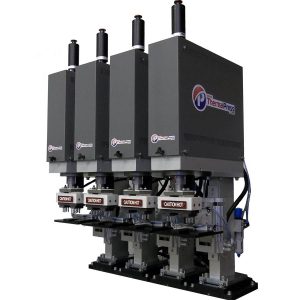
Quick-Change Tooling Improves Auto Infotainment Display Production
Auto instrument clusters and infotainment systems are undergoing great changes.
Starting in the mid-2010s, automakers found that the worldwide push towards mobile touchscreen technology seen in smartphones and tablets applies directly to auto instrument clusters and infotainment systems.
Now, the auto industry has fully embraced the touchscreen as part of a consolidated instrument cluster solution that removes the bulky knobs and buttons of the past with a sleek, new, integrated appearance.
For manufacturers of auto instrument clusters, this represents a potentially disrupting development. Nonetheless, experts predict that now-advanced features like internet connection will be standard on all in-car infotainment systems by 2025. These devices can account for up to 15 percent of a car’s price.
As with any field in the process of substantial change, adaptability and flexibility are the most important doctrines to follow.
High quality plastic assembly solutions that allow for quick-change tooling will be increasingly important as infotainment systems continue to improve.
Plastic Assembly for Touch Screen Infotainment Systems
Manufacture of auto infotainment displays is no longer a simple matter of sliding all-in-one components in and out of a main assembly and joining them through a single uniform heat staking process.
Systems are becoming increasingly modular, which gives manufacturers the responsibility of joining disparate systems quickly and efficiently.
Auto parts manufacturers will increasingly find themselves responsible for attaching and testing these individual modular components, often in strictly specific sequence. Since production facility managers cannot change the sequence, they will have to implement multiple tooling changeovers.
Manufacturers using the latest ultrasonic welding systems can easily find themselves adding hours to production time with each tooling changeover. Heat staking and swaging machines typically provide for shorter tooling changeover times, but only premium heat staking machines guarantee tooling kit changeovers on the order of mere minutes without any re-adjustments or alignment requirements.
Automotive manufacturers and their tier 1 component suppliers need to stay ahead of the latest developments in infotainment display production. A typical pain point is the changeover from attaching printed circuit boards to the display assembly. Rarely will a manufacturer find that the same plastic assembly process applies to the components themselves and the assembly that houses them.
Rely on Quick Changeovers for Future Adaptability
Automotive component manufacturers often find themselves focused so intently on the pressing needs of the present that they leave themselves unprepared for the future.
Customer expectations concerning auto infotainment displays will continue to change at an increasing rate, as competition over new technologies generate demand throughout the auto sector.
To implement an efficient assembly process, manufacturers may purchase multiple single-purpose high-performance machines. However, if the next decade promises an era of transition, it can be challenging to ensure that such an investment will deliver results in the long term.
The best procurement strategy places a priority on quick changeovers, modular functionality, and scalability. Manufacturers that purchase new equipment with an eye for compatibility with future processes will be able to guarantee improved rate of return on the investment over time.